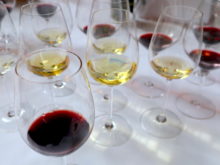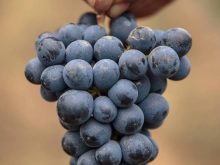
The Spanish writer Cervantes wasn’t merely tilting at windmills when he extolled the virtues of Abruzzo wines in his 17th-century novels. For more than 400 years, oenophiles have celebrated this region in central Italy for its Trebbiano d’Abruzzo and Montepulciano d’Abruzzo wines.
While the region has been associated with cooperative wineries, the president of the Consorzio Tutela Vini D’Abruzzo, Davide Acerra, asserts, “a new generation of producers represent new hope for a beloved region.” The region boasts more than 200 private wineries, many of which practice sustainable farming alongside the iconic “Abruzzo pergola” seen in the majority of the vineyards.
Unlike most other European wine-producing regions, Abruzzo includes three national parks within its domain, which is flanked by the Apennine mountains along its western border and the Adriatic Sea to the east. While 80% of the region is cultivated with Abruzzo’s Trebbiano and Montepulciano grapes, other varieties include Pecorino, Passerina, Cococciola and Montonico.

According to Acerra, the rosé wine known as Cerasuolo d’Abruzzo is “the wine of the heart of the people” of Abruzzo. One of the best examples of that local favorite is produced at Vini Valori, the winery created in 1996 by former soccer star Luigi Valori. Valori’s rendition of this vibrant cherry-pink rosé beautifully captures the vivacity of Abruzzo’s new generation of wine producers.
First produced in 2011, Vini Valori Cerasuolo d’Abruzzo DOC BIO is organically cultivated at 300 meters above sea level. Easy to drink as an aperitif, the wine is freshly floral on the nose with a bright acidity that pairs nicely with the region’s signature seafood soup known as Brodetto alla Vastese.

In keeping with the innovative spirit of Abruzzo’s new generation of winemakers, Francesco Cirelli of La Collina Biologica utilizes amphora from Tuscany sealed with stainless-steel lids. In the vineyards, Cirelli follows biodynamic practices using organic fertilization such as cow horn manure. Hand-harvested, the grapes are transferred into clay amphorae for fermentation and aged for nine months. The fruit of Cirelli’s passion is beautifully realized in Cirelli Anfora Montepulciano d’Abruzzo DOC 2019. A ruby-colored biodynamic wine with expressive red fruit and balsamic aromas and ripe velvety tannins, this deeply complex wine proves a fitting complement for Abruzzo’s eclectic cuisine.
As a brand ambassador for Abruzzo and a member of Les Dames d’Escoffier, Susannah Gold recently hosted a lunch at Manhattan’s Il Gattopardo where the wines of Abruzzo were featured alongside three sweet wines from Bordeaux. A professed Francophile in her early life, Gold fell under the spell of Italian viticulture, but maintains a fondness for Bordeaux’s sweet wines due in part to that magical amalgam of sweetness and acidity. Some stellar representations of Bordeaux’s sweet wines can be found at Château de Garbes, Château Fayau, and Château Loupiac-Gaudiet.

As pleasing as the sweet wines were as a post-prandial finish, my palate—and my mind—remained fixated on an Abruzzo wine from Castorani. At meal’s end, what I yearned for most was another glass of Podere Castorani, Montepulciano d’Abruzzo Casauria Riserva 2015.
The estate known as Castorani takes its name from a star-crossed 18th-century villa which was revitalized in 1999 by a group of friends who purchased the vineyards. At Castorani, 2015 was an outstanding year, and Podere Castorani, Montepulciano d’Abruzzo Casauria Riserva 2015 is a tribute to the region’s clement weather.

A deep ruby red wine with violet tints, there’s licorice on the nose with forest berries, and a hint of crushed violets. I kept wishing for another bowl of Il Gattopardo’s spaghetti chitarra with marinara and basil. Something simple to savor the wine’s full body and elegant tannins, that long finish that lingers. Who needs a cigar when there’s a wine as supple as this? Waiter, please—another bowl and another bottle!





